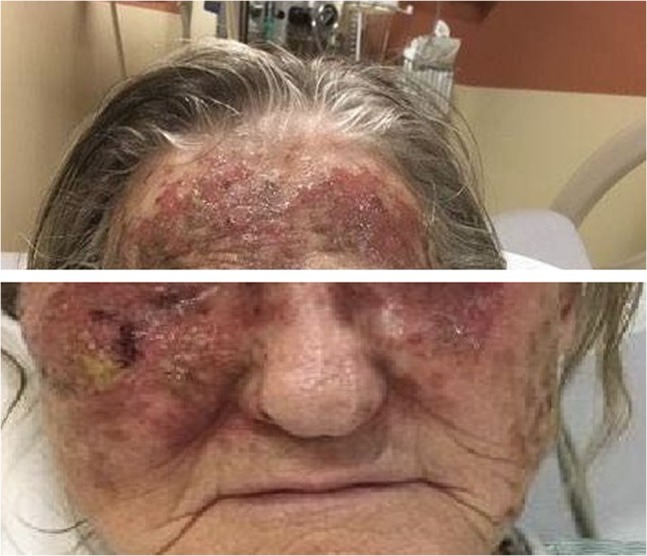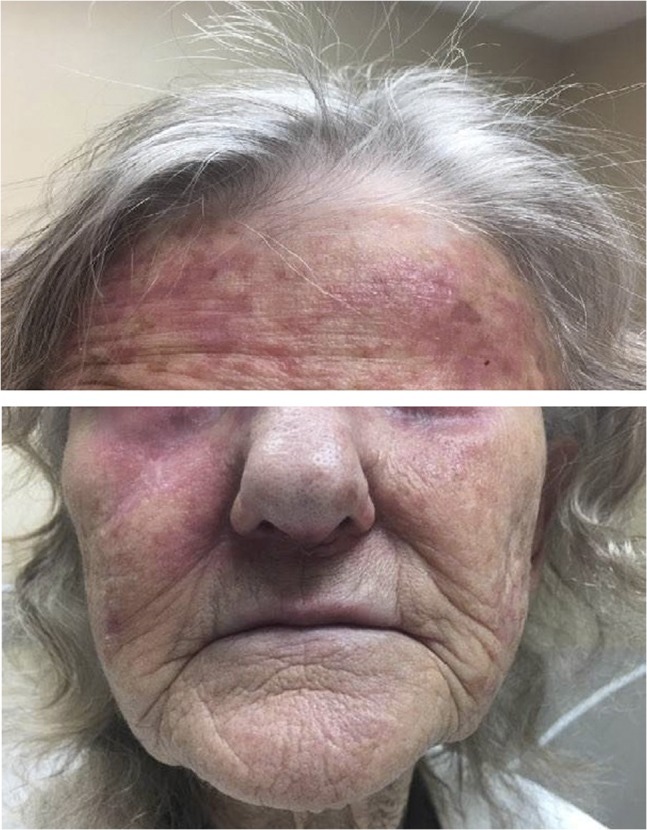Abstract
Topical 5- Fluorouracil (5-FU) is used more frequently to treat actinic keratosis. We are presenting a skin reaction as a side effect of this medication. Treatment for such cases of 5-FU-induced skin reactions is based on proper skin care and treatment of any superimposed infections. Medical providers should be aware of such side effects to provide their patients with proper instructions to avoid complications.
A 76-year-old female presented to an outpatient dermatologist’s office with facial actinic keratosis (AK). Skin biopsy revealed nonspecific verrucous squamous hyperplasia. She was prescribed 5% 5-fluorouracil (5-FU) cream, and asked to apply it to the face twice a day for 2 weeks. Instead, the patient reported that she was applying it seven times a day. She then presented to the emergency department with blistering, peeling and painful erythema of the face focused around the forehead, eyes and cheeks (Fig. 1). There was no involvement of mucosal surfaces. She was noted to have a small area of honey-colored crusting on her right cheek.
Figure 1:

Erythema of the face around the forehead, eyes and cheeks. Small area of honey-colored crusting on right cheek.
Skin damage can result from topical 5-FU which inhibits thymidylate synthetase. Topical 5-FU was shown to decrease AK counts and the need for spot treatments for longer than 2 years [1]. In addition to superficial discomfort, 5-FU can lead to skin erosion, desquamation and re-epithelialization. This may increase the risk of superimposed skin infections. About 5% 5-FU is associated with higher frequency of skin side effects mainly skin irritation [2].
Treatment for such cases of 5-FU-induced skin reactions are based on proper skin care and treatment of any superimposed infections. In our case, 5-FU cream was discontinued, and patient was educated on suitable skin care with liberal application of petroleum jelly. She was treated with antibiotics for impetigo. Regular follow-up on an outpatient basis is important to ensure that the skin is healing appropriately. One week follow-up in outpatient clinic showed healing skin with resolved infection (Fig. 2).
Figure 2:

Resolving erythema and honey-colored crusting.
CONFLICT OF INTEREST STATEMENT
None declared.
REFERENCES
- 1. Pomerantz H, Hogan D, Eilers D, Swetter SM, Chen SC, Jacob SE, et al. . Long-term efficacy of topical fluorouracil cream, 5%, for treating actinic keratosis: a randomized clinical trial. JAMA Dermatol 2015;151:952. [DOI] [PubMed] [Google Scholar]
- 2. Levy S, Furst K, Chern W. A pharmacokinetic evaluation of 0.5% and 5% fluorouracil topical cream in patients with actinic keratosis. Clin Ther 2001;23:908. [DOI] [PubMed] [Google Scholar]


